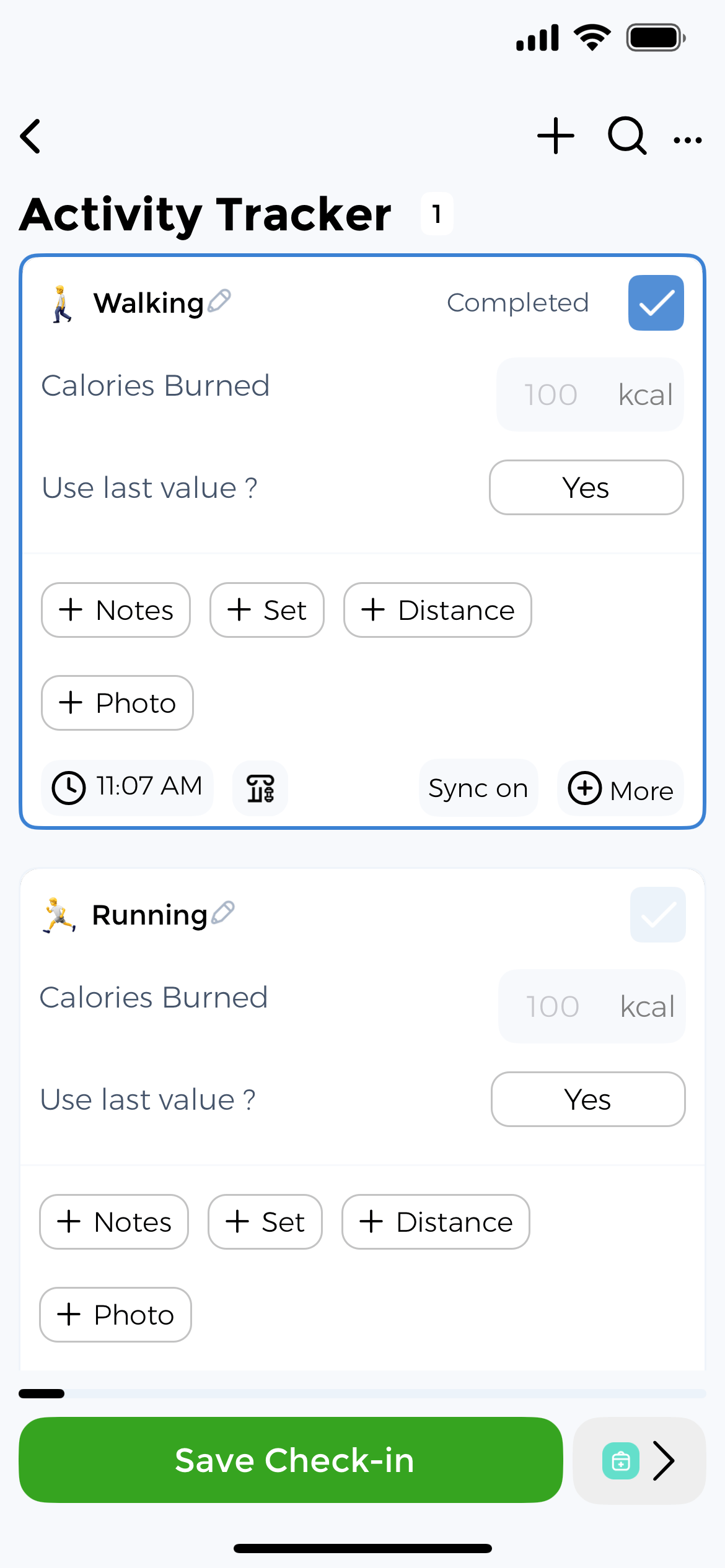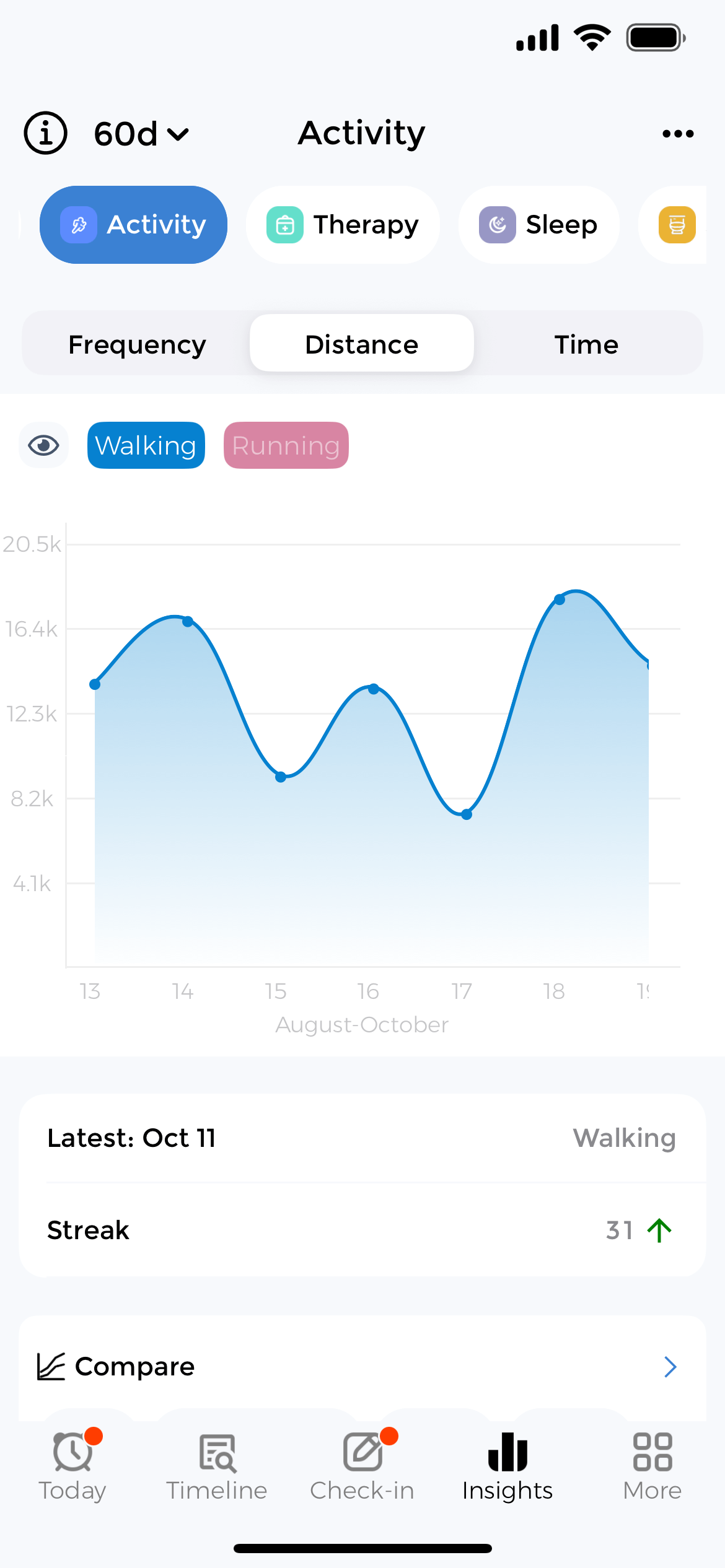Activity Tracker
Discover which activities reduce your symptoms.
Activity tracking is more than just steps. CareClinic helps you log walks, exercise, physical therapy sessions, and daily movement to see how activity impacts your symptoms, energy levels, and overall wellbeing.

Track Every Type of Movement
Whether it’s rehabilitation exercises, daily walks, or physical therapy sessions, log activities that support your recovery and wellbeing.
Or Create Custom Activities
Quick Logging & Auto-Sync
Quick manual entries or automatic syncing from your favorite devices.
Three Simple Steps
1. Add Your Activities
Log walks, workouts, physical therapy, or any movement. Sync devices or add entries manually with notes and duration.
2. Track Consistently
Build a daily habit with quick check-ins. Use reminders and device sync to maintain your activity timeline without effort.
3. See Health Connections
Discover how movement affects energy, symptoms, and sleep. Share visual progress reports with your care team.
500+ Exercise Library
Access hundreds of clinically-reviewed exercises with instructions, demonstrations, and tracking templates.
Discover Activity Impact
Automatically correlate activity data with symptoms, energy levels, and other health metrics.
What You Can Uncover:
Problem: Chronic pain worsens some days without clear triggers
Insight: 20-minute walks reduce pain scores by 35% within 2 hours
Outcome: Schedule daily walks before pain peaks and share correlation data with physical therapist
Problem: Post-surgical PT adherence is questioned by insurance
Insight: Timestamped logs show 98% adherence to prescribed exercises over 12 weeks
Outcome: Submit professional PDF report proving consistent rehabilitation participation
Problem: Fatigue crashes happen randomly throughout the week
Insight: Energy levels drop 40% on days with less than 3,000 steps
Outcome: Set minimum movement goals and track energy improvements over time
Problem: Sleep quality varies wildly with no apparent cause
Insight: Exercise after 7pm correlates with 45% worse sleep scores
Outcome: Shift workouts to morning hours and monitor improved rest quality
Problem: Joint stiffness seems to worsen with rest days
Insight: Arthritis pain scores 30% lower on days with gentle movement vs complete rest
Outcome: Replace full rest days with light stretching and walking to maintain joint mobility
Movement & Health Connections
See connections between activity levels and your symptoms, energy, and wellbeing.
Activity-Symptom Correlation
Discover which activities reduce symptoms or trigger flare-ups. Visual charts show patterns between movement and pain, fatigue, or inflammation levels.
Sleep Quality Impact
See how exercise timing and intensity affect your sleep. Find the right balance of activity that improves rest without causing exhaustion.
Energy Level Patterns
Track how different activities impact daily energy. Identify optimal exercise types and durations that boost vitality without causing post-activity crashes.
Medication Effectiveness
Understand how physical activity enhances or interferes with medications. Share these insights with providers to optimize treatment timing.
Rehabilitation Progress
Document PT adherence and recovery milestones. Prove progress to insurers and therapists with clear before-and-after activity trends.
Mood & Mental Health
Correlate exercise with mood scores and anxiety levels. Identify which activities provide the best mental health benefits for your unique needs.
Ready to track your activity journey?
Stop guessing which activities help your health. Start tracking movement to see data-driven proof of what improves your symptoms, energy, and recovery.
Clinical-Grade Activity Reports
Unlike basic fitness trackers, CareClinic shows how movement relates to your specific health challenges. Correlate steps with pain levels, exercise with energy scores, and physical therapy with recovery progress.
- Visual correlation between activity and symptom improvement patterns
- Export professional PDF reports showing activity adherence for insurance or providers
- Compare different activity types side-by-side to identify what helps recovery most
- Track long-term trends to prove rehabilitation progress or treatment effectiveness
Beyond Fitness Tracking
Activity tracking integrates with other trackers to provide a complete picture of your health.
User Success Stories
Discover how activity tracking helped others improve recovery and understand their health better.
After my knee surgery, I needed to prove to insurance that I was doing my physical therapy exercises. Logging each PT session in CareClinic gave me proof of adherence, plus I discovered that morning exercises reduced my pain better than afternoon sessions. My therapist loved seeing the data trends.
Michael T.
Post-Surgical Recovery • Tracking for 4 months













